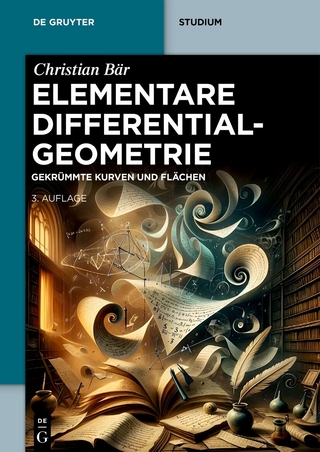
Kleinian Groups
Springer Berlin (Verlag)
978-3-642-64878-6 (ISBN)
I. Fractional Linear Transformations.- I.A. Basic Concepts.- I.B. Classification of Fractional Linear Transformations.- I.C. Isometric Circles.- I.D. Commutators.- I.E. Fractional Reflections.- I.F. Exercises.- II. Discontinuous Groups in the Plane.- II.A. Discontinuous Groups.- II.B. Area, Diameter, and Convergence.- II.C. Inequalities for Discrete Groups.- II.D. The Limit Set.- II.E. The Partition of C.- II.F. Riemann Surfaces.- II.G. Fundamental Domains.- II.H. The Ford Region.- II.I. Precisely Invariant Sets.- II.J. Isomorphisms.- II.K. Exercises.- II.L. Notes.- III. Covering Spaces.- III.A. Coverings.- III.B. Regular Coverings.- III.C. Lifting Loops and Regions.- III.D. Lifting Mappings.- III.E. Pairs of Regular Coverings.- III.F. Branched Regular Coverings.- III.G. Exercises.- IV. Groups of Isometries.- IV.A. The Basic Spaces and their Groups.- IV.B. Hyperbolic Geometry.- IV.C. Classification of Elements of Cn.- IV.D. Convex Sets.- IV.E. Discrete Groups of Isometries.- IV.F. Fundamental Polyhedrons.- IV.G. The Dirichlet and Ford Regions.- IV.H. Poincaré's Polyhedron Theorem.- IV.I. Special Cases.- IV.J. Exercises.- IV.K. Notes.- V. The Geometric Basic Groups.- V.A. Basic Signatures.- V.B. Half-Turns.- V.C. The Finite Groups.- V.D. The Euclidean Groups.- V.E. Applications to Non-Elementary Groups.- V.F. Groups with Two Limit Points.- V.G. Fuchsian Groups.- V.H. Isomorphisms.- V.I. Exercises.- V.J. Notes.- VI. Geometrically Finite Groups.- VI. A. The Boundary at Infinity of a Fundamental Polyhedron.- VI.B. Points of Approximation.- VI.C. Action near the Limit Set.- VI.D. Essentially Compact 3-Manifolds.- VI.E. Applications.- VI.F. Exercises.- VI.G. Notes.- VII. Combination Theorems.- VII.A. Combinatorial Group Theory - I.- VII.B. Blocks and Spanning Discs.-VII.C. The First Combination Theorem.- VII.D. Combinatorial Group Theory - II.- VII.E. The Second Combination Theorem.- VII.F. Exercises.- VII.G. Notes.- VIII. A Trip to the Zoo.- VIII.A. The Circle Packing Trick.- VIII.B. Simultaneous Uniformization.- VIII.C. Elliptic Cyclic Constructions.- VIII.D. Fuchsian Groups of the Second Kind.- VIII.E. Loxodromic Cyclic Constructions.- VIII.F. Strings of Beads.- VIII.G. Miscellaneous Examples.- VIII.H. Exercises.- VIII.I. Notes.- IX. B-Groups.- IX.A. An Inequality.- IX.B. Similarities.- IX.C. Rigidity of Triangle Groups.- IX.D. B-Group Basics.- IX.E. An Isomorphism Theorem.- IX.F. Quasifuchsian Groups.- IX.G. Degenerate Groups.- IX.H. Groups with Accidental Parabolic Transformations.- IX.I. Exercises.- IX.J. Notes.- X. Function Groups.- X.A. The Planarity Theorem.- X.B. Panels Defined by Simple Loops.- X.C. Structure Subgroups.- X.D. Signatures.- X.E. Decomposition.- X.F. Existence.- X.G. Similarities and Deformations.- X.H. Schottky Groups.- X.I. Fuchsian Groups Revisited.- X.J. Exercises.- X.K. Notes.- Special Symbols.
| Erscheint lt. Verlag | 18.9.2011 |
|---|---|
| Reihe/Serie | Grundlehren der mathematischen Wissenschaften |
| Zusatzinfo | XIII, 328 p. |
| Verlagsort | Berlin |
| Sprache | englisch |
| Maße | 155 x 235 mm |
| Gewicht | 527 g |
| Themenwelt | Mathematik / Informatik ► Mathematik ► Geometrie / Topologie |
| Schlagworte | Approximation • area • convergence • Dimension • Field • Finite • finite group • Function • group theory • Hyperbolic Geometry • Invariant • mapping • Riemann surface • Theorem • uniformization |
| ISBN-10 | 3-642-64878-9 / 3642648789 |
| ISBN-13 | 978-3-642-64878-6 / 9783642648786 |
| Zustand | Neuware |
| Haben Sie eine Frage zum Produkt? |
aus dem Bereich


